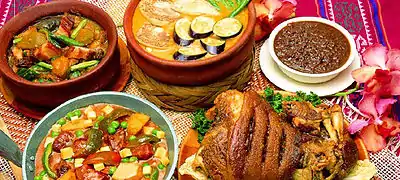Jaggery
Jaggery is a traditional non-centrifugal cane sugar[1] mainly consumed in the Indosphere.[2] It is a concentrated product of cane juice and often date or palm sap without separation of the molasses and crystals, and can vary from golden brown to dark brown in colour, and is similar to the Latin American panela.[2] It contains up to 50% sucrose, up to 20% invert sugars, and up to 20% moisture, with the remainder made up of other insoluble matter, such as wood ash, proteins, and bagasse fibres.[2]
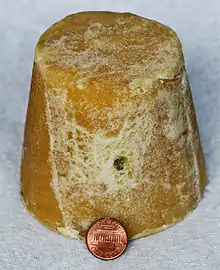 A block of jaggery, with a US penny for size comparison | |
| Place of origin | South Asia |
|---|---|
Etymology
Jaggery comes from Indo-Portuguese jágara, jagra, from Kannada ಶರ್ಕರೆ (śarkare) or Hindi शक्कर (śakkar)/Urdu (śakkar)شکر , ultimately from Sanskrit शर्करा (śárkarā), meaning ground sugar, candy, gravel, etc. It is a doublet of sugar.[3]
Origins and production
Jaggery is made of the products of sugarcane and the toddy palm tree. The sugar made from the sap of the date palm is more prized and less commonly available outside of the regions where it is made. The toddy palm is tapped for producing jaggery in India, Bangladesh, Pakistan, Nepal, Myanmar and Sri Lanka.
In Sri Lanka, syrup extracts from kithul (Caryota urens) trees are widely used for jaggery production.[4]
All types of the sugar come in blocks or pastes of solidified concentrated sugar syrup heated to 200 °C (392 °F). Traditionally, the syrup is made by boiling raw sugarcane juice or palm sap in large, shallow, round-bottomed vessels.
Preparation
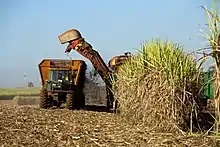
Historically, the sugarcane cultivators used crushers that were powered by oxen, but all modern crushers are power-driven. These crushers are placed in fields near the sugarcane plants. The cut and cleaned sugarcane is crushed and the extracted cane juice is collected in a large vessel. A certain quantity of the juice is transferred to a smaller vessel for heating on a furnace.
The vessel is heated for about an hour. Dried wood pulp from the crushed sugarcane is traditionally used as fuel for the furnace. While boiling the juice, lime is added to it so that all the wood particles rise to the top of the juice in a froth, which is skimmed off. Finally, the juice is thickened. The resulting thick liquid is about one-third of the original volume.
This hot liquid is golden. It is stirred continuously and lifted with a spatula to observe whether it forms a thread or drips while falling. If it forms many threads, it has completely thickened. It is poured into a shallow flat-bottomed pan to cool and solidify. The pan is extremely large to allow only a thin coat of this hot liquid to form at its bottom, so as to increase the surface area for quick evaporation and cooling. After cooling, the jaggery becomes a soft solid that is molded into the desired shape. The quality of jaggery is judged by its colour; brown means it is higher in impurities and golden-yellow implies it is relatively pure. Due to this grading scale, coloured adulterants are sometimes added to jaggery to simulate the golden hue.
Uses
South Asia (Indian subcontinent) and Southeast Asia
Jaggery is used as an ingredient in sweet and savoury dishes in the cuisines of India, Bangladesh, Nepal, Sri Lanka, Afghanistan, Iran and Pakistan. For example, a pinch of it is sometimes added to sambar, rasam and other staples in Udupi cuisine. Jaggery is added to lentil soups (dāl) to add sweetness to balance the spicy, salty, and sour components, particularly in Gujarati cuisine.
In Sri Lanka, jaggery is usually made using the syrup of the kithul palm tree, or from coconut syrup. The respective names in Sinhalese are kitul hakuru (කිතුල් හකුරු) and pol hakuru (පොල් හකුරු). Jaggery from the syrup of the Palmyrah palm is more prominent in the northern part of the country; this is referred to as palmyrah jaggery or thal hakuru (තල් හකුරු). Jaggery made from sugarcane syrup is considered inferior to these types of palm syrup based jaggery varieties, and the term jaggery (හකුරු) is generally understood in the country to refer to palm syrup based jaggery rather than sugarcane jaggery.[4]
Maharashtra in India is the largest producer and consumer of jaggery (gur (गुड़) in Hindi, "gul" (गुळ) in Marathi, "gur" (گڑ) in Urdu, "bellam" (బెల్లం) in Telugu, and bella (ಬೆಲ್ಲ) in Kannada) and In Tamil “Vellam”(வெல்லம்)
Kolhapur is one of the largest producers of jaggery in India and has a GI Tag for Jaggery.[5] Most vegetable dishes, curries, and dals, and many desserts contain it. Jaggery is especially used during Makar Sankranti for making a dessert called tilgul. In Gujarat, a similar preparation known called tal na ladu or tal sankli is made. In rural Maharashtra and Karnataka, water and a piece of jaggery are given to a person arriving home from working under a hot sun. In Indian culture during the New Year feast, jaggery-based sweets are made. In Karnataka on Ugadi festival day (Karnataka New Year), before starting the feast Neem leaves and jaggery are consumed together symbolising life; neem which is bitter in taste symbolizes the hurdles in one's life, and jaggery which is sweet in taste symbolizes happiness in life.
Molasses (काकवी), a byproduct of the production of jaggery, is used in rural Maharashtra and Karnataka as a sweetener. It contains many minerals not found in ordinary sugar and is considered beneficial to health in traditional Ayurvedic medicine.[6] It is an ingredient of many sweet delicacies, such as gur ke chawal / chol ("jaggery rice"), a traditional Rajasthani or Punjabi dish.
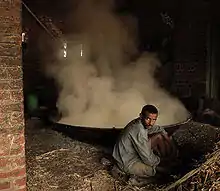
In Gujarat, laddus are made from wheat flour and jaggery. A well-known Maharashtrian recipe, puran poli, uses it as a sweetener apart from sugar. Jaggery is considered an easily available sweet which is shared on any good occasion. In engagement ceremonies, small particles of it are mixed with coriander seeds (ધાણા). Hence, in many Gujarati communities, engagement is commonly known by the metonym gol-dhana (ગોળ-ધાણા), literally "jaggery and coriander seeds".
Jaggery is used extensively in South India to balance the pungency of spicy foods. In Andhra Pradesh, and Tamil Nadu it is used for sweets such as chakkara pongal and milk pongal (prepared with rice, milk, jaggery). During Sankranti, Ariselu, an authentic Andhra Pradesh dish, is prepared, and in Tamil Nadu, ellurundai (sesame balls), Adhirasam and pori vilangu urundai (puffed rice balls) are prepared as offering - called prasadam - to God during puja and festivals such as Diwali, Tamil New Year and Janmashtami.
A sweet liquid called "Paanakam", made of water, jaggery and peppercorns is prepared as the favorite offering to Lord Rama during Rama Navami festival. In Kerala, it is considered auspicious and is widely used in cooking. It is a vital ingredient in many varieties of payasam, a sweet dish.
In Tamil Nadu, jaggery is used exclusively as a sweetener. It is used in a dish called chakkarai pongal. It is prepared during the festival of Pongal (Thai Pongal), which is held when the harvesting season begins. It is used to make kalhi, to sweeten fruit salads and payasam (sweet milk) that are offered to the Gods. Jaggery is used in religious rituals. In rural areas, cane jaggery and palm jaggery are used to sweeten beverages, whereas refined sugar has replaced it in urban areas.
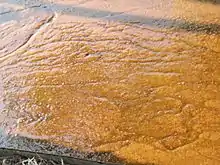
In Odia cuisine, cakes or piṭhas contain jaggery. Pithas like Arisa pitha are made out of jaggery called as guda in Odia. Kakara pitha contains coconut filings which are caramelized using jaggery. Guda is also added to rice flakes known as chuda and eaten for breakfast. Some marmalade made of mango and dillenia contain the ingredient.
In Bengali Hindu cuisine, it is commonly used in making sweet dishes, some of which mix jaggery with milk and coconut. Popular sweet dishes such as laḍḍu/laṛu or paṭishapta piṭha mix it with coconut shreds. Jaggery is molded into novel shapes as a type of candy. The same preparation of sweets have been made in its neighbouring state of Assam. Some of the popular sweet dishes of Assam such as til-pitha (made of rice powder, sesame and jaggery), other rice-based pitha, and payas are made of jaggery. In some villages of Assam, people drink salty red tea with a cube of gurd (jaggery), which is popularly called cheleka-chah (licking tea).
Traditional Karnataka sweets, such as paayasa, obbattu (holige) and unday use different kinds of jaggery. A pinch is commonly added to sambar (a.k.a. huLi saaru) and rasam (a.k.a. saaru). Karnataka produces sugar and palm-based jaggery.
Muzaffarnagar in Uttar Pradesh has the largest jaggery market in the world, followed by Anakapalle in the Visakhapatnam District in Andhra Pradesh. The Kolhapur District in western Maharashtra is famous for its jaggery, which is yellow and much sought-after in Maharashtra and Gujarat. Mandya in Karnataka is known for its jaggery production.
In Myanmar, jaggery is harvested from toddy palm syrup. In central Myanmar and around Bagan (Pagan), toddy syrup is collected solely for making jaggery. The translucent white syrup is boiled until it becomes golden brown and then made into bite-size pieces. It is considered a sweet and is eaten by children and adults alike, usually in the afternoon with a pot of green tea. It has been referred to locally as Burmese chocolate. Toddy palm jaggery is sometimes mixed with coconut shreds, jujube puree or sesame, depending on the area. This type of jaggery is used in Burmese cooking, usually to add colour and enrich the food.
Other uses
Other uses include jaggery toffees and jaggery cake made with pumpkin preserve, cashew nuts, peanuts and spices. Jaggery may be used in the creation of alcoholic beverages such as palm wine.
Besides being a food, jaggery may be used (mixed in an emulsion with buttermilk and mustard oil) to season the inside of tandoor ovens.[7]
Jaggery is used in natural dying of fabric. It is also used in hookahs in rural areas of Pakistan and India.
Nomenclature
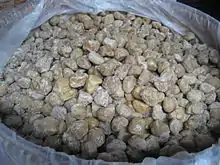
In South Asia
- From guḍa in Sanskrit (गुड, 'ball'):
- guṛ Bengali (গুড়), Bhojpuri (गुड़), Punjabi (ਗੁੜ), Haryanvi (गुड़), Hindi (गुड़), and Urdu (گڑ)
- gur in Assamese (গুৰ) and Nagamese (গুৰ)
- ɠuṛ in Sindhi (ڳُڙ)
- guḍô (ଗୁଡ) in Odia
- goḍ (Romanized godd) in Konkani (गोड)
- guḷ (गूळ) in Marathi
- gôḷ in Gujarati (ગોળ) and Rajasthani (गौळ)
- gwëṛa in Pashto (ګوړه)
In Southeast Asia
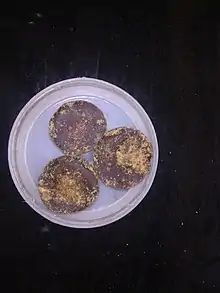
Myanmar (Burma)
- Htanyet (ထန်းလျက်) [Toddy Palm Jaggery] (pronounced [tʰəɲeʔ]) in Burmese
- Kyan Tha Kar (ကြံသကာ) [Sugarcane Jaggery] in Burmese

Malaysia
- Gula melaka or Gula merah in Malay
- Gula nisan/nise in Kelantanese Malay
- Gula apong in Sarawak, Malaysia is a variant of the jaggery, which is made from the sap of the nipah palm or Nypa fruticans.
Indonesia
- Gula jawa in Indonesian and Javanese
- Gula merah in Indonesian and Malay
- Gula aren in Indonesian and Betawi
- Gula kawung in Sundanese
Philippines
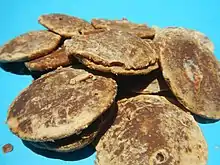
- Pakombuk (Kampampangan)
- Panocha (Philippine Spanish)
- Panutsa (Tagalog)
- Sangkaka (Tagalog)
- Bagkat Bao - may be regional to Bulacan (Tagalog)
- Calamay - Leyte and Samar (Waray-waray)
Thailand
- Palm jaggery: น้ำตาลโตนด, namtan tanot, pronounced [nám.tāːn tā.nòːt]
- Coconut jaggery: น้ำตาลมะพร้าว, namtan maphrao, pronounced [nám.tāːn mā.pʰráːw]
- Cane sugar: น้ำตาลอ้อย, namtan oi, pronounced [nám.tāːn ʔɔ̂j]
- Granulated brown cane sugar: น้ำตาลทรายแดง, namtan sai daeng, pronounced [nám.tāːn sāːj dɛ̄ːŋ]
- Granulated white cane sugar: น้ำตาลทราย, namtan sai, pronounced [nám.tāːn sāːj]; or น้ำตาลทรายขาว, namtan sai khao, pronounced [nám.tāːn sāːj kʰǎːw]
Elsewhere
- Raspadura in Cuba
- Rapadura in Brazil
- Panela in Central America and parts of South America
- Piloncillo in Mexico
- Tapa de dulce in Costa Rica
- Chancaca in Peru
- Papelón, panela or miel de panela in Venezuela
- Sukari nguuru in Swahili
- Kokuto (黒糖, Kokutō) in Japanese[8]
- 紅糖 (hóng táng) or 黑糖 (hēi táng) in Chinese, the latter used by the Chinese community in Southeast Asia
- Gur in Afghanistan
_in_Punjab.jpg.webp)
Image gallery
 Jaggery cubes
Jaggery cubes Jaggery (gur) making at small scale near sugarcane farm in Pakistan.
Jaggery (gur) making at small scale near sugarcane farm in Pakistan. Boiling the sugarcane juice in large-scale jaggery (gur) making in India.
Boiling the sugarcane juice in large-scale jaggery (gur) making in India.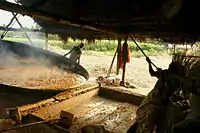 Transferring boiled sugarcane juice into vessel to dry.
Transferring boiled sugarcane juice into vessel to dry._Jaggery_Gud_Punjab_India.jpg.webp) Gud or jaggery: Sugarcane-derived raw sugar crystallised cubes or blocks.
Gud or jaggery: Sugarcane-derived raw sugar crystallised cubes or blocks. Jaggery blocks, also known as gud
Jaggery blocks, also known as gud Gur mamra laddu sweets made from jaggery and puffed rice.
Gur mamra laddu sweets made from jaggery and puffed rice. Indian Jaggery
Indian Jaggery
See also
- Brown sugar
- Muscovado – Type of unrefined brown sugar
- Caramelization
- Palm sugar – Sugar extracted from the sap of palm trees
- Panela – Unrefined whole cane sugar
- Piloncillo
- Peen tong – Chinese brown sugar
- Sugarloaf
References
- "New improvements in jaggery manufacturing process and new product type of jaggery". Panela Monitor. Retrieved 2014-08-30.
- "Media | Practical Action" (PDF). Itdg.org. Archived from the original (PDF) on 2004-01-07. Retrieved 2011-09-28.
- wikt:jaggery
- Balachander, Vidya (26 January 2017). "Sri Lanka's 'Kithul' Palm Syrup: An Ancient Sweetener In Need Of Saving". NPR.
- "Kolhapur: Second Largest market of gur" (PDF). IRJET. Retrieved 2018-05-14.
- "Jaggery and Confectionary". APEDA, Agricultural & Processed Food Products Export Development Authority. Ministry of Commerce and Industry, Government of India. Retrieved 2009-06-19.
- Kalra, J.I.S.; Das Gupta, P. (1986). Prashad Cooking with Indian Masters. Allied Publishers Private, Limited. p. 10. ISBN 9788170230069. Retrieved 2015-09-13.
- "Brown Sugar from Okinawa | Art of Eating". artofeating.com. Archived from the original on 2013-04-22. Retrieved 2015-09-13.

